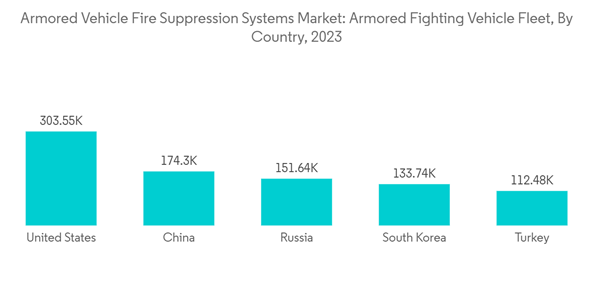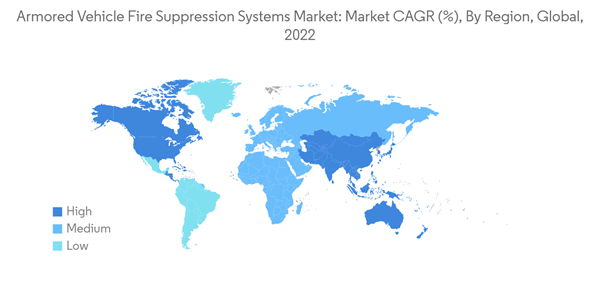The Armored Vehicle Fire Suppression Systems Market size is estimated at USD 24.42 million in 2024, and is expected to reach USD 27.38 million by 2029, growing at a CAGR of 2.31% during the forecast period (2024-2029).
Armored vehicles are designed to protect their occupants from various threats, such as bullets, explosives, fire, and chemical agents. The demand for armored vehicle fire suppression systems is expected to increase due to rising military expenditure. For instance, in 2022, global military expenditure reached USD 2,240 billion, a growth of 6% compared to 2021. Governments and military forces all over the world are investing in technologically advanced systems, such as armored vehicle fire suppression systems, given the increasing geopolitical tensions across the globe.
The escalating geopolitical rift in regions such as Asia-Pacific, Europe, and the Middle East has been generating demand for new armored vehicles to enhance the current capabilities of the ground forces. This, in turn, has created a parallel demand for fire suppression systems to mitigate the damage and threat to both passengers and critical systems. However, the high R&D costs associated with the systems and the fast pace of evolution of new weaponry, such as high explosive anti-tank (HEAT) warheads, lower the effective service life and efficacy of such systems, rendering them incapable of providing optimal protection.
The demand for combat vehicles is expected to increase due to rising military expenditure and the armored vehicles that are being procured by major countries such as the United States, China, Russia, South Korea, and Turkey. Most countries have undertaken armored vehicle procurement or upgrade plans to modernize and enhance their military capabilities. For instance, in June 2022, the US Army awarded a contract to General Dynamics Land Systems for its Mobile Protected Firepower program. As part of its multi-billion modernization effort, the US Army's next-generation combat vehicle portfolio is working on the development of future ground vehicles, including the mobile protected firepower program and the Optionally Manned Fighting Vehicle (OMFW).
Even smaller countries based in third-world regions are also inducting new armored vehicles into active service. For instance, in October 2023, Otokar was awarded a contract by Estonia for ARMA 4X4 and 6X6 armored personal vehicles for USD 137 million. The deliveries are planned to take place between 2024 and 2025. The vehicle has automatic fire extinguishing and explosion suppression system. Thus, with the demand for armored vehicles on the rise, the subsequent requirement for fire suppression systems/components is also anticipated to increase during the forecast period.
The increasing use of sophisticated sensor systems to detect a fire outbreak has also enhanced the complexity of the system, which has driven the cost of such systems. Modern fire suppression systems, such as those produced by Ares, can detect a fire in less than three milliseconds and suppress it within 250 milliseconds. Army collaboration with research institutes has driven the development of better fire suppression systems by upgrading the existing old-school systems. For instance, in March 2021, the National Institute of Standards and Technology (NIST) developed a new interactive tool to help the US Army fight the fire effectively using the right amount of pressure parameters to extinguish the fire. New armored vehicle programs such as the Next-Generation Combat Vehicle (NGCV) are envisioned to drive the demand for fire suppression systems market in the region during the forecast period.
This product will be delivered within 2 business days.
Armored vehicles are designed to protect their occupants from various threats, such as bullets, explosives, fire, and chemical agents. The demand for armored vehicle fire suppression systems is expected to increase due to rising military expenditure. For instance, in 2022, global military expenditure reached USD 2,240 billion, a growth of 6% compared to 2021. Governments and military forces all over the world are investing in technologically advanced systems, such as armored vehicle fire suppression systems, given the increasing geopolitical tensions across the globe.
The escalating geopolitical rift in regions such as Asia-Pacific, Europe, and the Middle East has been generating demand for new armored vehicles to enhance the current capabilities of the ground forces. This, in turn, has created a parallel demand for fire suppression systems to mitigate the damage and threat to both passengers and critical systems. However, the high R&D costs associated with the systems and the fast pace of evolution of new weaponry, such as high explosive anti-tank (HEAT) warheads, lower the effective service life and efficacy of such systems, rendering them incapable of providing optimal protection.
Armored Vehicle Fire Suppression Systems Market Trends
Combat Vehicles to Witness Highest Growth During the Forecast Period
The crew compartment in armored combat vehicles such as infantry fighting vehicles (IFVs) provides limited space for the body movement of troops. This escalates a hazardous situation wherein the occupants may be subjected to lethal fire burn or suffocation due to smoke inhalation. Most current fire suppression systems are solid-based. However, the recent advancements in technology, such as the introduction of gas-based suppression agents that are less corrosive and have high oxygen deprivation capability, have driven the adoption of gas-based armored vehicle fire suppression systems.The demand for combat vehicles is expected to increase due to rising military expenditure and the armored vehicles that are being procured by major countries such as the United States, China, Russia, South Korea, and Turkey. Most countries have undertaken armored vehicle procurement or upgrade plans to modernize and enhance their military capabilities. For instance, in June 2022, the US Army awarded a contract to General Dynamics Land Systems for its Mobile Protected Firepower program. As part of its multi-billion modernization effort, the US Army's next-generation combat vehicle portfolio is working on the development of future ground vehicles, including the mobile protected firepower program and the Optionally Manned Fighting Vehicle (OMFW).
Even smaller countries based in third-world regions are also inducting new armored vehicles into active service. For instance, in October 2023, Otokar was awarded a contract by Estonia for ARMA 4X4 and 6X6 armored personal vehicles for USD 137 million. The deliveries are planned to take place between 2024 and 2025. The vehicle has automatic fire extinguishing and explosion suppression system. Thus, with the demand for armored vehicles on the rise, the subsequent requirement for fire suppression systems/components is also anticipated to increase during the forecast period.
North America to Dominate the Market Share During the Forecast Period
North American countries, especially the United States and Canada, are amongst the top military spenders globally. The United States has actively deployed its troops in conflict-affected regions such as the Middle East, wherein large-scale use of rocket-propelled explosive projectiles and Improvised Explosive Devices (IEDs) pose a major threat to the safety of armored vehicles and troops inside them. This factor has significantly propelled the market development of safety measures such as fire suppression and extinguishing systems for Main Battle Tanks (MBTs), Armored Personnel Carriers (APCs), IFVs, etc.The increasing use of sophisticated sensor systems to detect a fire outbreak has also enhanced the complexity of the system, which has driven the cost of such systems. Modern fire suppression systems, such as those produced by Ares, can detect a fire in less than three milliseconds and suppress it within 250 milliseconds. Army collaboration with research institutes has driven the development of better fire suppression systems by upgrading the existing old-school systems. For instance, in March 2021, the National Institute of Standards and Technology (NIST) developed a new interactive tool to help the US Army fight the fire effectively using the right amount of pressure parameters to extinguish the fire. New armored vehicle programs such as the Next-Generation Combat Vehicle (NGCV) are envisioned to drive the demand for fire suppression systems market in the region during the forecast period.
Armored Vehicle Fire Suppression Systems Industry Segmentation
The armored vehicle fire suppression systems market is semi-consolidated in nature, with a few players holding significant shares. Some of the prominent players in the market are N2 Towers Inc., Spectrex (Emerson Electric Co.), Fire Protection Technologies Pty Ltd, Kidde-Deugra Brandschutzsysteme GmbH (RTX Corporation), and Halma PLC. The stringent safety and regulatory policies in the defense segment are expected to restrict the entry of new players. Since a contract for armored vehicles requires high technological expertise and spans several years, careful identification and continuous monitoring of associative risks are required to be undertaken to assess their effects on the operational parameters of the manufacturing company.Additional Benefits:
- The market estimate (ME) sheet in Excel format
- 3 months of analyst support
This product will be delivered within 2 business days.
Table of Contents
1 INTRODUCTION
4 MARKET DYNAMICS
5 MARKET SEGMENTATION
6 COMPETITIVE LANDSCAPE
Companies Mentioned (Partial List)
A selection of companies mentioned in this report includes, but is not limited to:
- Halma plc
- N2 Towers Inc
- Fire Protection Technologies
- Spectrex Inc.
- Marotta Controls Inc.
- Bulldog Direct Protective Systems
- Kidde-Deugra Brandschutzsysteme GmbH
- ExploSpot Systems Pty Ltd.
- Nero Industries
- Mikro-Pulssi Oy
Methodology

LOADING...










